Creating content your audience loves takes time, but making it profitable shouldn’t. That’s where Google AdSense comes in.
With AdSense, trusted advertisers show their ads on your site, generating revenue for you to keep creating great content and take your business to the next level. AdSense gets you the best of Google’s automation and is fully customizable. Plus, signing up is free and easy.
Join more than 2 million publishers who are already earning money from their sites with Google AdSense. Get started today!
Category Archives: Inside AdSense
Join the Women of Publishing webinar series
The 2020 Women of Publishing Leadership Series is now open for registration. This annual program is designed to facilitate industry connections, provide access to resources, and enable the future growth of women-led small publishing businesses. Apply by February 21 to join us on the live stream sessions, as well as an in-person event bringing together our female publishing community.
What you can expect
This March, the Women of Publishing Leadership Series is bringing together female entrepreneurs and leaders, who have successfully funded their passions through monetization platforms using Google AdMob or AdSense. The first online class kicks off on March 10, just after International Women's Day.
This multi-part web series will teach you how Google tools can help to fuel the growth of your publishing business. The course will include data-driven monetization tactics for both web and apps, as well as discussions on sustaining momentum in this fast-paced and evolving digital ecosystem.
You can find detailed information about the online course below:
Keynote
Date and time: Tuesday, March 10 at 1:30 PM ET
Summary: Join an honest discussion on one woman’s journey in the publishing industry. We will also discuss how to optimize your audience engagement strategy.
Monetization and Reporting Deep-Dive, Web
Date and time: Tuesday, March 17 at 1:30 PM ET
Summary: Get a closer look at how to efficiently earn more for your website using the new and improved AdSense Auto ads.
Monetization and Reporting Deep-Dive, Apps
Date and time: Thursday, March 19 at 1:30 PM ET
Summary: Learn how to think about optimizing your app’s monetization structure and which metrics matter the most in tracking your app’s performance.
Protecting our Digital Ecosystem
Date and time: Tuesday, March 24 at 1:30 PM ET
Summary: Gain insight on how to maintain user trust and secure your content in an evolving ecosystem.
Google is committed to women’s success in the publishing industry
We’ve seen great strides toward women’s parity in the global labor market in recent years. However, there’s still work to do. The empowerment of female entrepreneurship is especially critical. Globally, there are less women than men among entrepreneurs, contributing to the 50 percent gap in total income (all types of revenues) between men and women.
The Women of Publishing Leadership Series was designed to help participants learn how to maximize the value of their publishing business and earn more revenue. The curriculum is tailored for small and medium-sized businesses. Women from all types of digital backgrounds: apps, news, gaming, entertainment, video, e-commerce, etc. are encouraged to apply. Not using Google AdMob, AdSense, or Ad Manager? No worries—join the program to learn which product best suits your business needs.
Applications close on February 21, 2020. Join the 2020 Women of Publishing community by applying on our website.
Source: Inside AdSense
Join the Women of Publishing webinar series
The 2020 Women of Publishing Leadership Series is now open for registration. This annual program is designed to facilitate industry connections, provide access to resources, and enable the future growth of women-led small publishing businesses. Apply by February 21 to join us on the live stream sessions, as well as an in-person event bringing together our female publishing community.
What you can expect
This March, the Women of Publishing Leadership Series is bringing together female entrepreneurs and leaders, who have successfully funded their passions through monetization platforms using Google AdMob or AdSense. The first online class kicks off on March 10, just after International Women's Day.
This multi-part web series will teach you how Google tools can help to fuel the growth of your publishing business. The course will include data-driven monetization tactics for both web and apps, as well as discussions on sustaining momentum in this fast-paced and evolving digital ecosystem.
You can find detailed information about the online course below:
Keynote
Date and time: Tuesday, March 10 at 1:30 PM ET
Summary: Join an honest discussion on one woman’s journey in the publishing industry. We will also discuss how to optimize your audience engagement strategy.
Monetization and Reporting Deep-Dive, Web
Date and time: Tuesday, March 17 at 1:30 PM ET
Summary: Get a closer look at how to efficiently earn more for your website using the new and improved AdSense Auto ads.
Monetization and Reporting Deep-Dive, Apps
Date and time: Thursday, March 19 at 1:30 PM ET
Summary: Learn how to think about optimizing your app’s monetization structure and which metrics matter the most in tracking your app’s performance.
Protecting our Digital Ecosystem
Date and time: Tuesday, March 24 at 1:30 PM ET
Summary: Gain insight on how to maintain user trust and secure your content in an evolving ecosystem.
Google is committed to women’s success in the publishing industry
We’ve seen great strides toward women’s parity in the global labor market in recent years. However, there’s still work to do. The empowerment of female entrepreneurship is especially critical. Globally, there are less women than men among entrepreneurs, contributing to the 50 percent gap in total income (all types of revenues) between men and women.
The Women of Publishing Leadership Series was designed to help participants learn how to maximize the value of their publishing business and earn more revenue. The curriculum is tailored for small and medium-sized businesses. Women from all types of digital backgrounds: apps, news, gaming, entertainment, video, e-commerce, etc. are encouraged to apply. Not using Google AdMob, AdSense, or Ad Manager? No worries—join the program to learn which product best suits your business needs.
Applications close on February 21, 2020. Join the 2020 Women of Publishing community by applying on our website.
Source: Inside AdSense
Refining your website’s user experience in 3 steps
There are plenty of sites out there. Beyond producing great content, it’s vital to make yours stand out. How? One way is to provide an exceptional user experience (UX).
Use tools to put yourself in your user’s shoes, and then rectify anything that compromises their ability to move easily through your site. In turn, these optimizations can produce a positive impact on the performance of your ads.

1. Measure your site’s performance
As a first step, assess your current website user experience to understand what developments are needed.
Track important metrics about how your site performs in Google Search results using Search Console. Find out how often your site appears, its average position, click-through rates and more.
The Performance report provides visibility into how your search traffic changes over time, where it’s coming from and what search queries are most likely to show your site. See which pages have the highest (and lowest) click-through rate from Google Search.
Expose untapped performance opportunities and improve the quality of web pages through Lighthouse. With Lighthouse audits, you can identify and then fix common problems that affect your site’s performance, accessibility and user experience.
Run a mobile-friendly test to see how easily a visitor can use your page on a mobile device. Just enter a page URL to find how you score. The majority of users coming to your site are likely to be using a mobile device, so if you haven’t made your site mobile-friendly, you should.
With 53 percent of users abandoning mobile sites that take longer than three seconds to load, it pays to be fast. Check your mobile page speed and compare it against industry benchmarks.
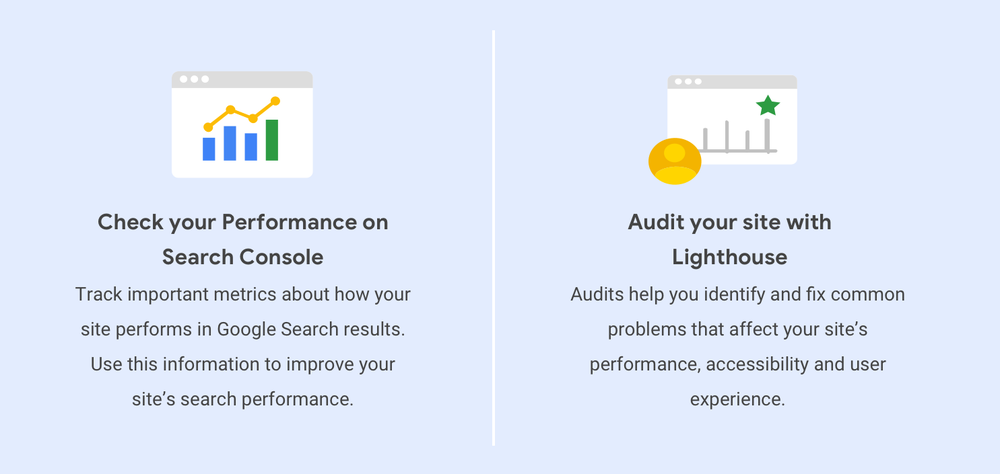
2. Design for optimal user experience
Now that you know how your site measures up, it’s time to put your analysis to use with UX strategies for improvements. There are three development frameworks you can consider using to create a smoother, faster experience for your users.
AMP (Accelerated Mobile Pages) is a framework of web components that lets you create a highly performing site that’s consistently fast across all devices.
Responsive web design is about using HTML and CSS to automatically resize, shrink or enlarge a website to make it look good on all devices, including desktops, tablets and phones.
Progressive Web Apps provide an installable, app-like experience on desktop and mobile. Built and delivered directly via the web, these web apps are fast and reliable on any browser.
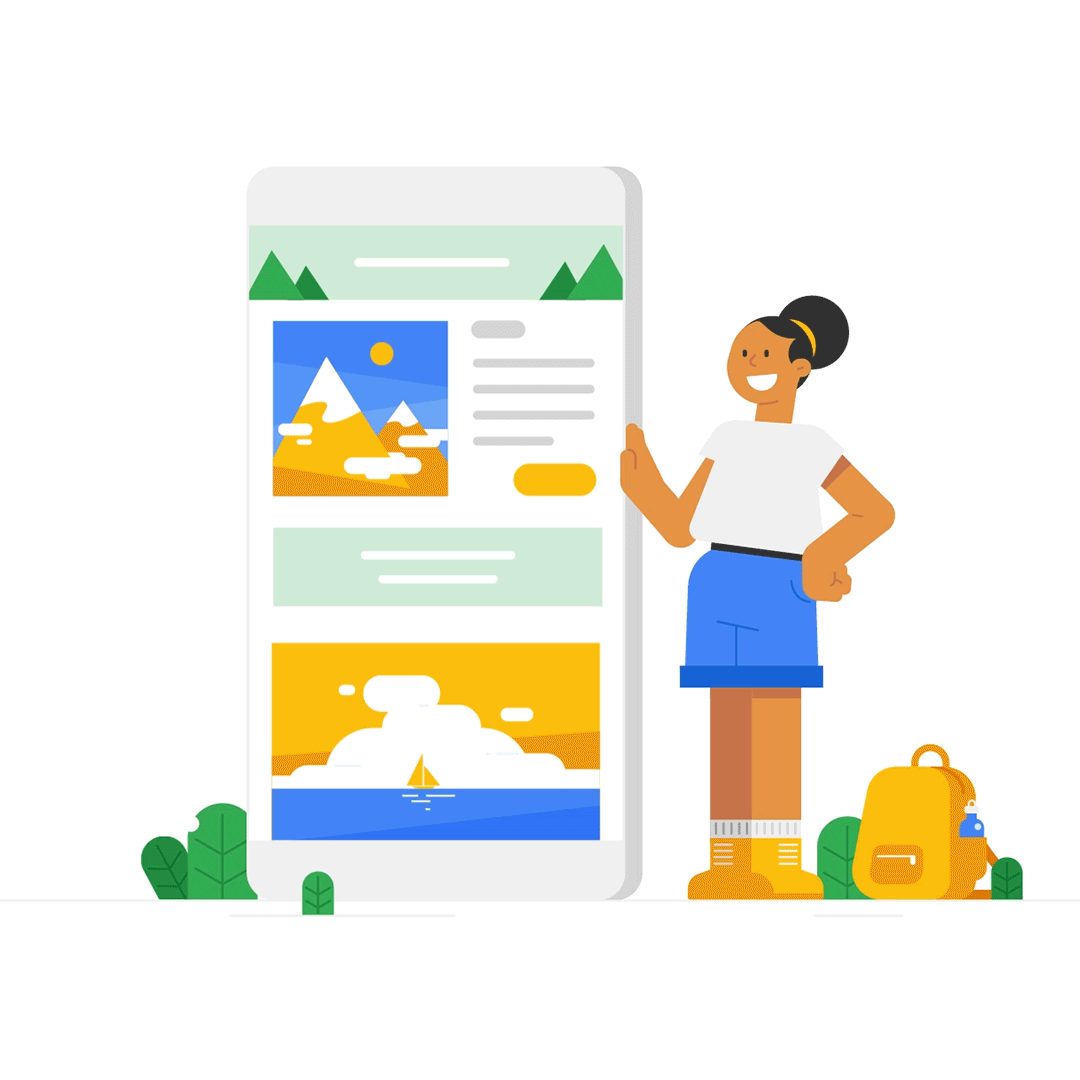
3. Keep mobile front of mind
Since the majority of users now access Google Search with a mobile device, the mobile version of your site’s content is what informs indexing and ranking. If your site has separate desktop and mobile content, here’s what you need to remember to optimize for mobile-first indexing.
Your mobile site should contain the same content as your desktop site.
Structured data should be present on both versions of your site.
Metadata should be present on both versions of the site.
When it comes to design, remember that users are impatient – so organise your site so that it’s easy for people to find and do what they want. Focus your homepage and navigation on connecting users to the content they’re looking for. Offer site search to ensure users can find what they need in a hurry. Understand your customer journeys and let users convert on their own terms. Provide a seamless, frictionless conversion experience through easy-to-use forms.
To learn more about what you can do to propel your website user experience from good to great, check out these mobile design best practices.
Source: Inside AdSense
Refining your website’s user experience in 3 steps
There are plenty of sites out there. Beyond producing great content, it’s vital to make yours stand out. How? One way is to provide an exceptional user experience (UX).
Use tools to put yourself in your user’s shoes, and then rectify anything that compromises their ability to move easily through your site. In turn, these optimizations can produce a positive impact on the performance of your ads.
1. Measure your site’s performance
As a first step, assess your current website user experience to understand what developments are needed.
Track important metrics about how your site performs in Google Search results using Search Console. Find out how often your site appears, its average position, click-through rates and more.
The Performance report provides visibility into how your search traffic changes over time, where it’s coming from and what search queries are most likely to show your site. See which pages have the highest (and lowest) click-through rate from Google Search.
Expose untapped performance opportunities and improve the quality of web pages through Lighthouse. With Lighthouse audits, you can identify and then fix common problems that affect your site’s performance, accessibility and user experience.
Run a mobile-friendly test to see how easily a visitor can use your page on a mobile device. Just enter a page URL to find how you score. The majority of users coming to your site are likely to be using a mobile device, so if you haven’t made your site mobile-friendly, you should.
With 53 percent of users abandoning mobile sites that take longer than three seconds to load, it pays to be fast. Check your mobile page speed and compare it against industry benchmarks.

2. Design for optimal user experience
Now that you know how your site measures up, it’s time to put your analysis to use with UX strategies for improvements. There are three development frameworks you can consider using to create a smoother, faster experience for your users.
AMP (Accelerated Mobile Pages) is a framework of web components that lets you create a highly performing site that’s consistently fast across all devices.
Responsive web design is about using HTML and CSS to automatically resize, shrink or enlarge a website to make it look good on all devices, including desktops, tablets and phones.
Progressive Web Apps provide an installable, app-like experience on desktop and mobile. Built and delivered directly via the web, these web apps are fast and reliable on any browser.

3. Keep mobile front of mind
Since the majority of users now access Google Search with a mobile device, the mobile version of your site’s content is what informs indexing and ranking. If your site has separate desktop and mobile content, here’s what you need to remember to optimize for mobile-first indexing.
Your mobile site should contain the same content as your desktop site.
Structured data should be present on both versions of your site.
Metadata should be present on both versions of the site.
When it comes to design, remember that users are impatient – so organise your site so that it’s easy for people to find and do what they want. Focus your homepage and navigation on connecting users to the content they’re looking for. Offer site search to ensure users can find what they need in a hurry. Understand your customer journeys and let users convert on their own terms. Provide a seamless, frictionless conversion experience through easy-to-use forms.
To learn more about what you can do to propel your website user experience from good to great, check out these mobile design best practices.
Source: Inside AdSense
Creating outstanding website content in 3 steps
Great content marketing not only drives new visitors to your site, but also entices previous visitors to come back. A content strategy is key, so take advantage of these tools that can help.
1. Identify areas with high potential
Before you sit down to create any new website content, understand the interests and content consumption behavior of the users you’re aiming to reach. Find areas that offer the most potential. For instance, niche content ideas—those that have large amounts of interest or queries but few matching sites—are often worth tapping into because they offer a way to make your content stand out.
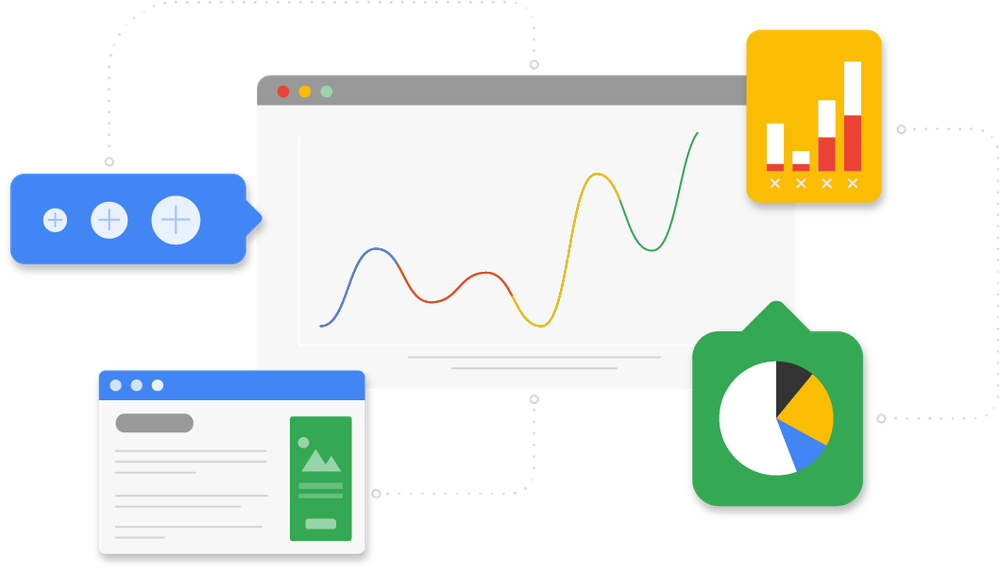
Google Trends shows what the world is searching for. It analyzes the popularity of top search queries in Google Search across regions and languages, and presents graphs to compare a query’s search volume over time. Keep up with trending searches, or enter any search term to discover related topics and queries. These techniques can give you a feel for what people are interested in so you can tailor your content to suit.
Google Question Hub collects unanswered questions directly from users to identify content gaps online. Use these insights to create better content for your audience.
Market Finder uncovers new opportunities to take your business global. It analyzes monthly searches, popular market trends, disposable income per capita and number of internet users by country to help you prioritize where your products, services and content will appeal most. Pinpoint a shortlist of promising new target markets for your brand and extend your site’s content to international users.
News Consumer Insights provides analysis about which traffic sources drive the most qualified users and how to better engage your visitors. For instance, when NCI shows that the number of visits per user is high but pages per visit is low, it’s a signal that your internal recirculation could be better. Put links to your best performing content at the bottom of articles and invite readers to click.
Don't forget: All content must adhere to Webmaster Quality Guidelines.
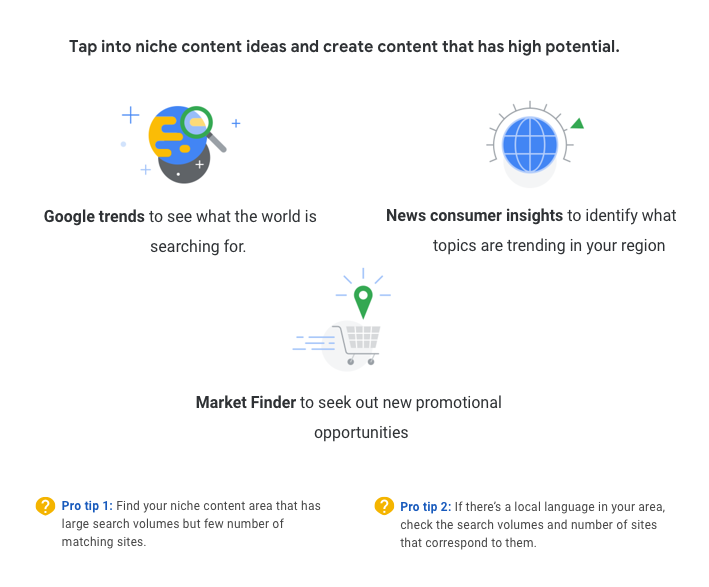
2. Improve your content marketing
Get to know your audience and how they engage with your site so you can see what’s working and what isn’t, then improve your content strategy accordingly. Google Analytics includes a host of free tools to help you build a more complete picture of your users and identify areas where you could be doing better.
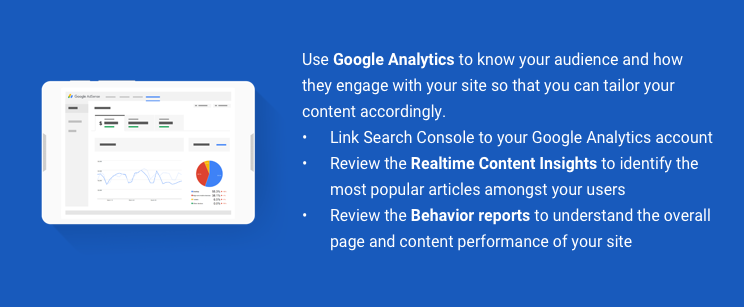
3. Learn from the latest tips and trends
Don’t forget to look at the bigger picture, including how people’s use of the web is evolving and how other businesses are responding.
Consumer Barometer shows how, when and why people around the world use the web. An evolving storehouse of online research and resources, it includes everything from country-specific data on consumers’ device preferences to insights about how people are making their purchase decisions.
Success storiesprovide inspiration and ideas from the wider community, showing how other people are using AdSense to help fund their passions.
Source: Inside AdSense
Creating outstanding website content in 3 steps
Great content marketing not only drives new visitors to your site, but also entices previous visitors to come back. A content strategy is key, so take advantage of these tools that can help.
1. Identify areas with high potential
Before you sit down to create any new website content, understand the interests and content consumption behavior of the users you’re aiming to reach. Find areas that offer the most potential. For instance, niche content ideas—those that have large amounts of interest or queries but few matching sites—are often worth tapping into because they offer a way to make your content stand out.
Google Trends shows what the world is searching for. It analyzes the popularity of top search queries in Google Search across regions and languages, and presents graphs to compare a query’s search volume over time. Keep up with trending searches, or enter any search term to discover related topics and queries. These techniques can give you a feel for what people are interested in so you can tailor your content to suit.
Google Question Hub collects unanswered questions directly from users to identify content gaps online. Use these insights to create better content for your audience.
Market Finder uncovers new opportunities to take your business global. It analyzes monthly searches, popular market trends, disposable income per capita and number of internet users by country to help you prioritize where your products, services and content will appeal most. Pinpoint a shortlist of promising new target markets for your brand and extend your site’s content to international users.
News Consumer Insights provides analysis about which traffic sources drive the most qualified users and how to better engage your visitors. For instance, when NCI shows that the number of visits per user is high but pages per visit is low, it’s a signal that your internal recirculation could be better. Put links to your best performing content at the bottom of articles and invite readers to click.
Don't forget: All content must adhere to Webmaster Quality Guidelines.

2. Improve your content marketing
Get to know your audience and how they engage with your site so you can see what’s working and what isn’t, then improve your content strategy accordingly. Google Analytics includes a host of free tools to help you build a more complete picture of your users and identify areas where you could be doing better.

3. Learn from the latest tips and trends
Don’t forget to look at the bigger picture, including how people’s use of the web is evolving and how other businesses are responding.
Consumer Barometer shows how, when and why people around the world use the web. An evolving storehouse of online research and resources, it includes everything from country-specific data on consumers’ device preferences to insights about how people are making their purchase decisions.
Success storiesprovide inspiration and ideas from the wider community, showing how other people are using AdSense to help fund their passions.
Source: Inside AdSense
Keep your audience engaged post holidays
Congrats on completing the marathon. What happens now?
You might notice a drop in your RPMs and impressions. Don’t panic, it’s ok. You didn’t do anything wrong it’s the January blues. Remember that RPMs and internet traffic drive spikes but can also drive drops. As internet traffic decreases after the holiday, it is common to experience a drop in January. This is your RPMs returning to normal. This represents a new opportunity for you to focus on retaining the audience you gained and experiment with your AdSense account.
How to retain your audience?
Top trending January
Users are still online in January but their searches are different. This could be the time of a year for a perfect match between their searches and your content. Users have many topics on their radar, such as lifestyle, health and travel.
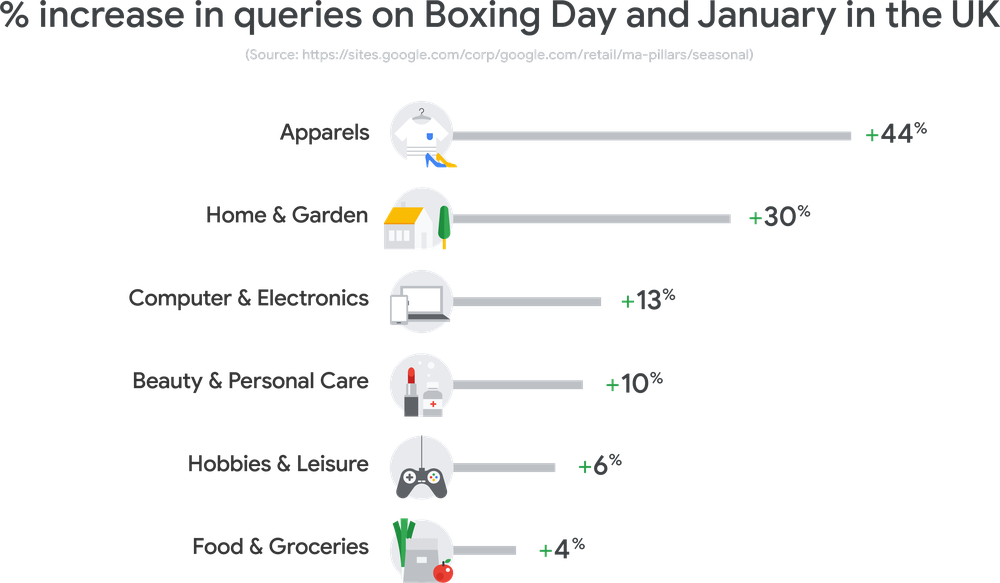
Check Google Trends to find out what search queries were trending in your audience’s location last January.
What about the next few months?
January isn’t the right time of the year that matches with your content? Good news, there’s a lot of seasonal holidays to watch out for in the following months. Here’s a list of seasonal peaks in 2020. Let’s find yours.
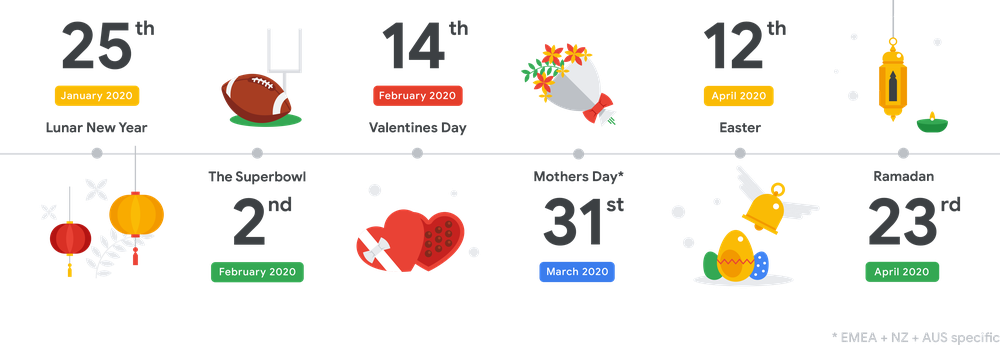
New year - new ideas
If you are thinking of starting a new site, make sure to take a look at these AMP-first tips. Creating an AMP-first site gives you a high performance - faster page load time, better user experience on mobile and more overall traffic. Review the WordPress themes that make creating an AMP site easy. Create the site, install theme and install the AMP plugin.
Experiment with your AdSense account
It’s time to have some fun and try out some changes. Is there a feature you wanted to test before the holiday but didn’t get a chance to implement it? Why not try it now? Visit the Optimization tab in your AdSense account. It provides you with bespoke recommendations that could improve performance, and A/B experiments to help you make more informed decisions for your site.
Learn more about opportunities and experiments.
End of quarter tip
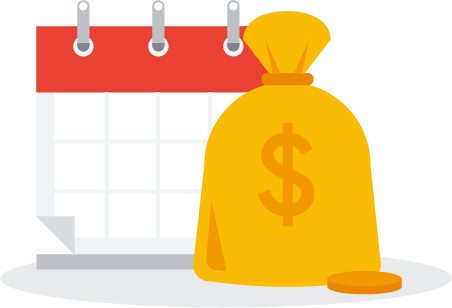
Take note of each end of quarter in your region. Why? Advertisers tend to spend more at the end of each quarter when they have budget leftover. Remember, an increase in advertiser spent also means potential increase of RPMs.
Source: Inside AdSense
Build your content during the holiday season

Holiday season is driven by users purchasing for themselves and for family’s gifts.
Don’t worry, even if your content is not related to the holiday season, a rise in internet traffic increases the probability of users landing on your page. Holiday season means an opportunity for all!
Create bespoke content

To attract and retain an audience, it’s important to tailor your content to your users’ needs. Here are some helpful insights to create engaging content during the holiday season.
- Think mobile size:
Users are increasingly searching on their mobiles. Smartphones accounted for the majority of digital shopping traffic for the first time this holiday season with 51% of visits according to Adobe1. Be mindful of the number of ads you show so users find it easy to digest on mobile. Keep your content short (and sweet). A recent Google study found that consumers ‘disliked mobile pages with ad densities greater than 30% and flashing animated ads2. Click here to learn more about mobile ad format optimization - Incorporate keywords into your content:
- Mobile searches for “best” have grown over 80% in two years3.
- The searches for Black Friday shopping increased by 1,150% on Google in 2018 from November to December4.
- ‘Where to buy’ is a trending search phrase during the holiday season. For example, “where to buy cards,” and “where to buy gift boxes”5. - Keep up to date with this season’s trends:
The Google Trends tool will help you discover what are the big internet search topic of the moment for your audience. Check Google Trends tool. Internet users are also increasingly hungry for video content. For this holiday season, look at what’s trending amongst viewers with Youtube trends. - Let’s talk SEO:
Let Google Search find your site! Understand the basics of crawling, indexing, serving and how Google Search works. Get your site on Google. - It's not over until it's over:
Keep publishing content throughout the season. Users are searching right up until Christmas. With new gadgets to unbox and explore, plenty of users will be online on Christmas Day itself, downloading apps, updating drivers and registering their devices. In fact, searches for ‘download’ and ‘activate’ are 30% higher on December 25th than during the week prior6.
Sources:
1. https://content-na1.emarketer.com/thanksgiving-day-is-now-the-no-3-online-shopping-holiday
2. https://www.thinkwithgoogle.com/marketing-resources/better-ad-standards/
3. https://www.thinkwithgoogle.com/data/holiday-search-statistics-store-hours/
4. https://trends.google.com/trends/explore?date=2018-11-01%202018-12-31
5. https://www.thinkwithgoogle.com/data/holiday-shopping-search-statistics/
Source: Inside AdSense
Build your content during the holiday season

Holiday season is driven by users purchasing for themselves and for family’s gifts.
Don’t worry, even if your content is not related to the holiday season, a rise in internet traffic increases the probability of users landing on your page. Holiday season means an opportunity for all!
Create bespoke content

To attract and retain an audience, it’s important to tailor your content to your users’ needs. Here are some helpful insights to create engaging content during the holiday season.
- Think mobile size: Users are increasingly searching on their mobiles. Smartphones accounted for the majority of digital shopping traffic for the first time this holiday season with 51% of visits according to Adobe1. Be mindful of the number of ads you show so users find it easy to digest on mobile. Keep your content short (and sweet). A recent Google study found that consumers ‘disliked mobile pages with ad densities greater than 30% and flashing animated ads2. Click here to learn more about mobile ad format optimization
- Incorporate keywords into your content:
- Mobile searches for “best” have grown over 80% in two years3.
- The searches for Black Friday shopping increased by 1,150% on Google in 2018 from November to December4.
- ‘Where to buy’ is a trending search phrase during the holiday season. For example, “where to buy cards,” and “where to buy gift boxes”5. - Keep up to date with this season’s trends: The Google Trends tool will help you discover what are the big internet search topic of the moment for your audience. Check Google Trends tool. Internet users are also increasingly hungry for video content. For this holiday season, look at what’s trending amongst viewers with Youtube trends.
- Let’s talk SEO: Let Google Search find your site! Understand the basics of crawling, indexing, serving and how Google Search works. Get your site on Google.
- It's not over until it's over: Keep publishing content throughout the season. Users are searching right up until Christmas. With new gadgets to unbox and explore, plenty of users will be online on Christmas Day itself, downloading apps, updating drivers and registering their devices. In fact, searches for ‘download’ and ‘activate’ are 30% higher on December 25th than during the week prior6.
Sources:
1. https://content-na1.emarketer.com/thanksgiving-day-is-now-the-no-3-online-shopping-holiday
2. https://www.thinkwithgoogle.com/marketing-resources/better-ad-standards/
3. https://www.thinkwithgoogle.com/data/holiday-search-statistics-store-hours/
4. https://trends.google.com/trends/explore?date=2018-11-01%202018-12-31
5. https://www.thinkwithgoogle.com/data/holiday-shopping-search-statistics/
